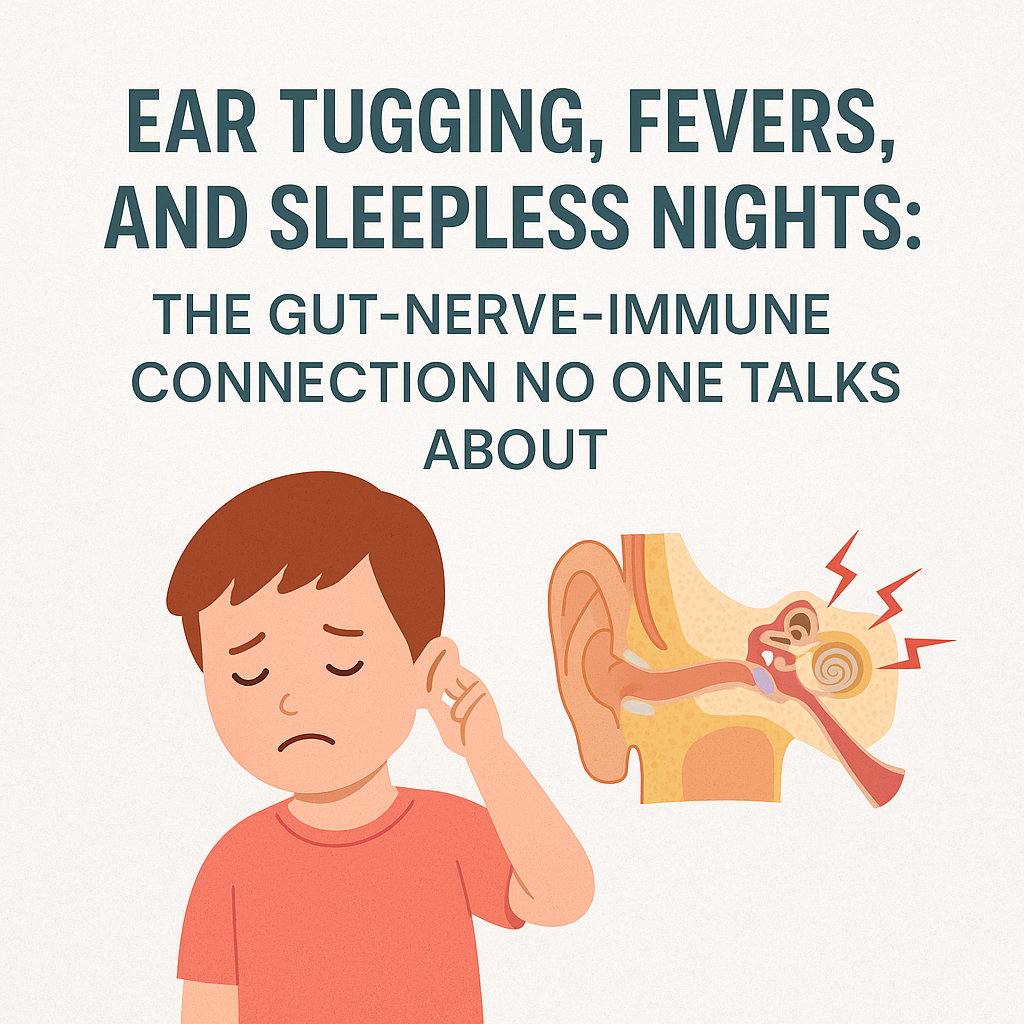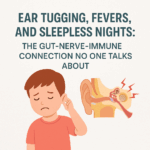If you’ve ever been up at 2 AM with a crying, feverish child tugging at their ear, you know how heartbreaking and exhausting it can be. Ear infections in children are extremely common – five out of six kids will have at least one by age three.
These infections often bring on all the telltale signs: constant ear tugging or rubbing, bouts of fussiness and crying, trouble sleeping through the night, and often a fever.
It’s no wonder ear infections are one of the top reasons parents rush their little ones to the doctor. But while most parents (and pediatricians) focus on treating the ears, there’s a deeper story unfolding behind the scenes – one that involves your child’s gut, nervous system, and immune system all working together.
This is the gut-nerve-immune connection that no one talks about, and understanding it could be the key to finally breaking the cycle of ear infections, fevers, and sleepless nights.
In this post, we’ll explore how these three systems (gut, nerve, and immune) are linked and why addressing them can help your child heal more gently and effectively. We’ll do it in plain language – no complicated medical jargon – with plenty of empathy for all the tired moms, dads, and caregivers out there. Let’s dive in.
Ear Infections: Why Is My Child Tugging at Their Ear?
When your child is pulling on their ear, irritable, and can’t sleep, an ear infection (often otitis media) is a likely cause. Fluid builds up behind the eardrum due to bacteria or viruses, causing pain and inflammation. Babies can’t say “Mom, my ear hurts,” so they show you through fussiness, crying, and sleeplessness.
Young children’s Eustachian tubes are small and horizontal, making drainage difficult. When your child gets a stuffy nose, germs can travel up these tubes and fluid gets trapped—creating a perfect environment for bacteria.
As Dr. Gene Liu explains:
“Children are more susceptible to ear infections because their Eustachian tubes are small and horizontal, which makes it difficult for fluid to drain.”
Children’s immune systems are still developing, so they’re more vulnerable. Each cold or virus increases the risk of another ear infection.
Typical treatment involves rest or antibiotics, but repeated antibiotic use can disrupt gut health and create resistant bacteria. Dr. Liu notes:
“Repeated use of antibiotics can compromise a child’s developing gut.”
This brings us to the bigger picture — how the gut, immune system, and nervous system interact.
The Gut-Immune Connection: Strong Tummy, Strong Immunity
About 70% of immune cells are in the gut. The gut microbiome “teaches” the immune system how to respond properly. When balanced, it reduces inflammation and helps fight infections.
When imbalanced (dysbiosis), inflammation rises and immune function weakens — even affecting the ENT region (ears, nose, throat).
Antibiotics can disrupt the gut microbiome by killing beneficial bacteria. Studies show children with three or more antibiotic-treated ear infections early in life had higher levels of inflammatory microbes.
Gut-Focused Strategies
- Nutrition & Probiotics: A diet rich in fruits, veggies, and fiber supports good bacteria. Probiotics or fermented foods may help reduce infection risk.
- Avoid Unnecessary Antibiotics: Many mild ear infections resolve naturally. Follow a “watch and wait” approach when appropriate.
- Hydration & Diet: Staying hydrated helps mucus drain. Reducing sugar and processed foods supports gut and immune health.
The Hidden Role of the Nervous System: Stress, Sleep, and the Vagus Nerve
The vagus nerve connects the brain to many organs (including the ears and gut) and helps regulate inflammation. When functioning well, it keeps the immune system balanced and calms the body.
However, poor sleep and stress — common during illness — can weaken immunity. Lack of sleep reduces immune cell activity, while stress hormones suppress immune function.
Chiropractic care can help by supporting nervous system balance. Gentle adjustments may improve vagal tone and ear drainage.
A study showed:
“93% of ear infection episodes improved and 75% of kids saw improvement within 10 days when chiropractic care was added.”
At home, parents can encourage calmness through deep breathing, humming, gentle rocking, upright feeding, and warm compresses — all of which activate the body’s rest-and-heal mode.
Breaking the Cycle: A Holistic Plan for Healing and Prevention
- Prioritize Gut Health – Nutrient-dense diet, probiotics, and hydration.
- Support the Immune System – Ensure adequate sleep, reduce stress, and keep routines calm.
- Gentle Nervous System Care – Pediatric chiropractic, craniosacral therapy, and calming practices to strengthen vagal function.
- Break the Antibiotic Cycle – Work with your pediatrician to avoid unnecessary antibiotic use; consult ENT for recurring issues.
- Listen to Your Child’s Body – Notice early signs of imbalance and act preventatively.
Remember — be kind to yourself and your child. Recurrent ear infections can take a toll, but understanding this gut-nerve-immune connection opens the door to true healing.
Gentle Healing at VWC: Caring for the Whole Child
At VWC, we focus on holistic, integrative care — addressing the gut, nervous system, and immune system together.
Our team uses gentle pediatric chiropractic adjustments and provides nutritional and educational support to empower parents.
Many families report better sleep, improved mood, and fewer ear infections after care.
“We don’t promise overnight miracles, but we do promise compassionate partnership to get to the root causes and support your child’s wellness naturally.”
A Personal Invitation
If your child struggles with recurrent ear infections, VWC invites you to schedule a free consultation.
Our holistic approach blends modern research with natural healing — helping your child thrive and your family finally rest.
Sources
- NIDCD – Ear Infections in Children
- Cedars-Sinai Blog – Why Ear Infections Are So Common in Kids
- UCLA Health – If you want to boost immunity, look to the gut
- Greater Knoxville ENT – Link Between Gut Health and ENT Health
- Wiertsema et al., Nutrients (2021)
- Cochrane Database Syst Rev (2019) – Probiotics for preventing acute otitis media
- Massachusetts General Hospital – The Vagus Nerve: A Key Player…
- Lurie Children’s Hospital – How to Boost Your Child’s Immune System
- INSIGHT CLA / Dr. David Fletcher – Chiropractic and Ear Infections
- UF/Sweden Study (2024) – Antibiotic-treated ear infections and gut microbiome changes



